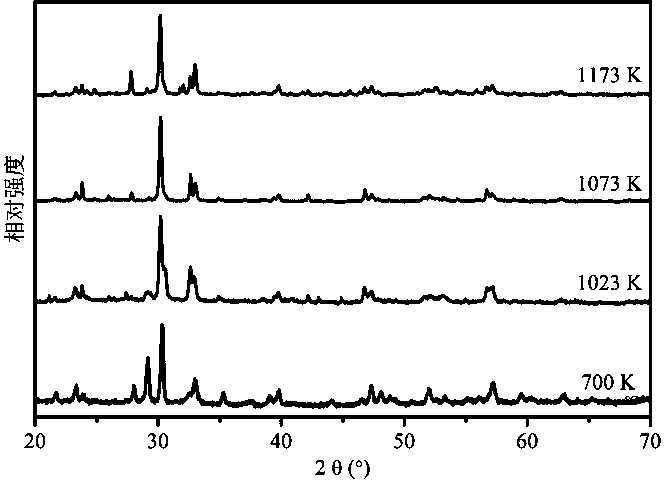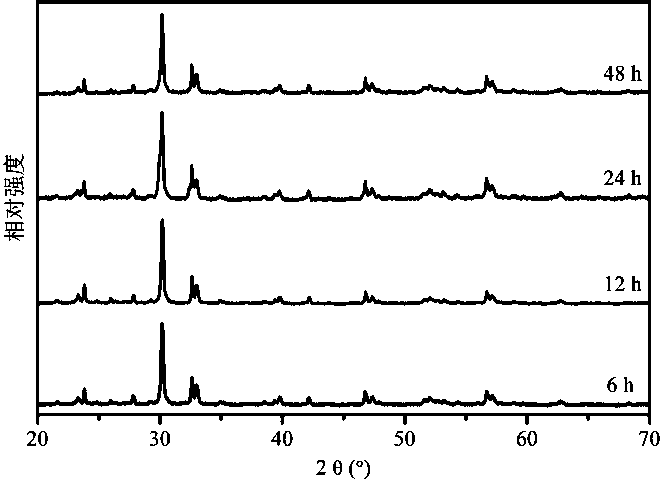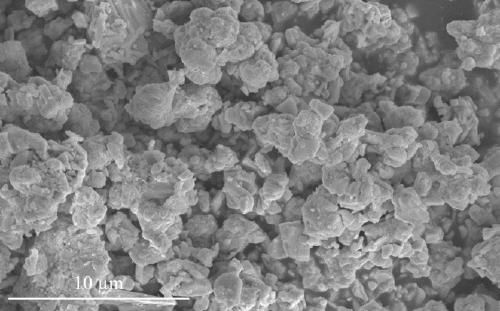Preparation method and application of bismuth-titanium-iron oxide chloride photocatalytic material
A technology of photocatalytic materials and oxychlorides, which is applied in the field of photocatalytic material synthesis technology, can solve the problems of wide band gap, high electron-hole recombination rate, and restriction of photocatalytic activity, and achieve small band gap value and hole The effect of low recombination rate and wide response range of visible light
- Summary
- Abstract
- Description
- Claims
- Application Information
AI Technical Summary
Problems solved by technology
Method used
Image
Examples
Embodiment 1
[0029] A preparation method of bismuth titanium iron oxychloride photocatalytic material, comprising the steps of:
[0030] The first step is to prepare bismuth oxychloride nanosheets: Weigh 2 mmol of bismuth nitrate pentahydrate and add it to 20 ml of ethylene glycol, stir with a magnetic stirrer to fully dissolve it, and record it as solution a. The stirring speed of the magnetic stirrer is 10-60 r / min; weigh 2 mmol potassium chloride and dissolve it in 10 ml distilled water, and record it as solution b; add solution b dropwise to solution a at a rate of 1-2 drops per second, and stir magnetically at room temperature for 1 h, stirring at a speed of 10-60 r / min, then centrifugally washing with distilled water at a centrifugal washing speed of 5000-9000rpm, putting the cleaned sample in an oven at 80°C and drying for 12 h to obtain bismuth oxychloride nanosheets;
[0031] The second step is to prepare bismuth titanium iron oxychloride: weigh 3 mmol bismuth oxide, 2 mmol titani...
Embodiment 2
[0034] A preparation method and application of a bismuth titanium iron oxychloride photocatalytic material, comprising the following steps:
[0035] The first step is to prepare bismuth oxychloride nanosheets: Weigh 2 mmol of bismuth nitrate pentahydrate and add it to 20 ml of ethylene glycol, stir with a magnetic stirrer to fully dissolve it, and record it as solution a. The stirring speed of the magnetic stirrer is 10-60 r / min; weigh 2 mmol potassium chloride and dissolve it in 10 ml distilled water, and record it as solution b; add solution b dropwise to solution a at a rate of 1-2 drops per second, and stir magnetically at room temperature for 1 h, stirring at a speed of 10-60 r / min, then centrifugally washing with distilled water at a centrifugal washing speed of 5000-9000rpm, putting the cleaned sample in an oven at 80°C and drying for 12 h to obtain bismuth oxychloride nanosheets;
[0036] The second step is to prepare bismuth titanium iron oxychloride: Weigh 3 mmol bis...
Embodiment 3
[0039] A preparation method and application of a bismuth titanium iron oxychloride photocatalytic material, comprising the following steps:
[0040] The first step is to prepare bismuth oxychloride nanosheets: Weigh 2 mmol of bismuth nitrate pentahydrate and add it to 20 ml of ethylene glycol, stir with a magnetic stirrer to fully dissolve it, and record it as solution a. The stirring speed of the magnetic stirrer is 10-60 r / min; weigh 2 mmol potassium chloride and dissolve it in 10 ml distilled water, and record it as solution b; add solution b dropwise to solution a at a rate of 1-2 drops per second, and stir magnetically at room temperature for 1 h, stirring at a speed of 10-60 r / min, then centrifugally washing with distilled water at a centrifugal washing speed of 5000-9000rpm, putting the cleaned sample in an oven at 80°C and drying for 12 h to obtain bismuth oxychloride nanosheets;
[0041] The second step is to prepare bismuth titanium iron oxychloride: Weigh 3 mmol bis...
PUM
 Login to View More
Login to View More Abstract
Description
Claims
Application Information
 Login to View More
Login to View More - R&D
- Intellectual Property
- Life Sciences
- Materials
- Tech Scout
- Unparalleled Data Quality
- Higher Quality Content
- 60% Fewer Hallucinations
Browse by: Latest US Patents, China's latest patents, Technical Efficacy Thesaurus, Application Domain, Technology Topic, Popular Technical Reports.
© 2025 PatSnap. All rights reserved.Legal|Privacy policy|Modern Slavery Act Transparency Statement|Sitemap|About US| Contact US: help@patsnap.com



